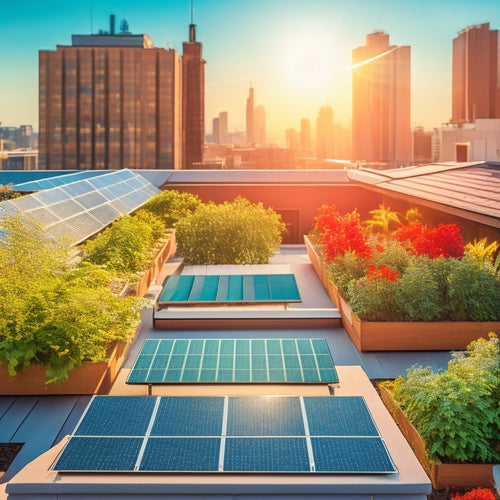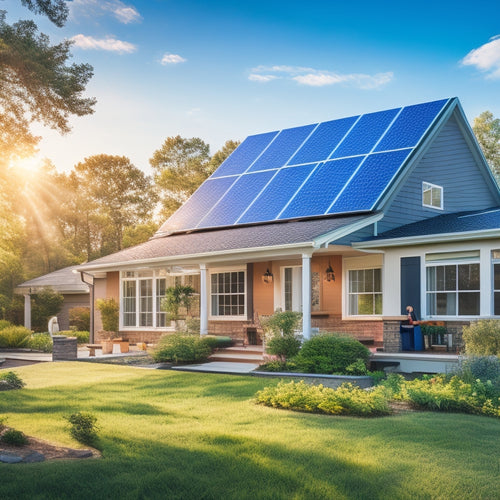
3 Best Residential Solar Panel Financing Options USA
Share
For the best residential solar panel financing options in the USA, consider federal tax credits, state incentive programs, and solar loans or leases. Federal tax credits cover up to 30% of installation costs, greatly reducing your tax liability. State programs like California's SGIP and New York's NY-Sun Initiative offer additional rebates and incentives tailored to your location. Solar loans and leases provide financial flexibility; loans come with ownership benefits and low interest rates, while leases require no upfront costs and fixed monthly payments. Exploring these options can maximize your savings and benefits from solar energy in your home. To fully understand your best choice, keep going.
Key Takeaways
- Federal tax credits cover up to 30% of solar panel installation costs, reducing overall expenses significantly.
- State incentive programs provide additional rebates and grants, varying by location, enhancing affordability.
- Solar loans offer low or zero down payments with interest rates between 3% to 8%, ensuring long-term savings.
- Leasing solar panels avoids upfront costs and includes maintenance, with fixed monthly fees for lower utility bills.
- Choosing between loans and leases depends on individual financial situations and long-term savings goals.
Federal Tax Credits
https://www.youtube.com/watch?v=ZHYfnO1hBNg
One significant advantage of financing your residential solar panels is the federal tax credit, which can cover up to 30% of installation costs. This incentive can make a substantial difference in your financial planning, potentially saving you thousands of dollars. But to benefit, you need to meet specific eligibility criteria. You must own the solar panel system (leasing disqualifies you), and it should be installed on your primary or secondary residence within the U.S.
The claim process is essential yet precise. First, make sure you have all receipts and documentation of the installation. When filing your federal taxes, use IRS Form 5695, titled 'Residential Energy Credits,' to calculate your credit. You'll then include the calculated amount on your Form 1040. It's vital to adhere to the guidelines and deadlines set by the IRS to avoid discrepancies.
Data shows that those who correctly claim this credit can significantly reduce their tax liability, freeing up funds for other investments. By understanding and leveraging these federal tax credits, you're not just saving money; you're making a powerful statement of energy independence and financial liberation.
State Incentive Programs
While federal tax credits provide a substantial incentive, state-level programs can further enhance your financial benefits by offering additional rebates and incentives tailored to your specific location. These state-specific rebate programs can greatly lower your initial investment, making solar panels more accessible.
For instance, California's Self-Generation Incentive Program (SGIP) offers substantial rebates for residential solar battery storage, while New York's NY-Sun Initiative provides both upfront and performance-based incentives.
Analyzing state grant initiatives reveals a diverse landscape aimed at empowering homeowners. States like Massachusetts and Colorado offer grants that can cover a substantial portion of your solar installation costs. Massachusetts' Commonwealth Solar II program provides rebates based on system size and household income, ensuring equitable access to solar energy.
Colorado's Renewable Energy Rebate Program, managed by the Colorado Energy Office, offers grants that can offset a significant portion of the installation expenses.
Solar Loans and Leases
Exploring solar loans and leases can provide you with flexible financial options to make solar power more attainable and cost-effective. Solar loans allow you to own the system outright, often with zero or low down payments, making it a liberating option if you're looking for long-term savings. Interest rates typically range from 3% to 8%, depending on your credit score and loan term, which can span from 5 to 20 years. This means you could potentially save thousands over the lifetime of your solar panels while also increasing your property value.
Leases, on the other hand, offer a different kind of freedom. By leasing, you avoid the upfront costs and maintenance responsibilities. Instead, you pay a fixed monthly fee to use the solar power generated by the system installed on your roof. While you won't own the system, you can still benefit from lower utility bills. The lease terms generally last 20 to 25 years, and they can include options to buy the system later or renew the lease.
Both options have their merits. Choosing between a solar loan and a lease depends on your financial situation, long-term goals, and the specific terms offered by providers.
Frequently Asked Questions
What Are the Typical Maintenance Costs for Residential Solar Panels?
You'll typically spend $150-$330 annually on maintenance. Cleaning frequency depends on your location, but expect twice yearly. Inverter replacement, costing around $1,000-$2,000, occurs every 5-10 years. Regular upkeep maximizes efficiency and longevity.
How Long Does It Take to Install Residential Solar Panels?
Imagine the clock ticking as you begin your solar journey. The installation timeline typically takes about one to three days, but the overall project duration, including permits and inspections, can stretch to a few weeks.
How Do Solar Panels Affect Home Insurance Policies?
When adding solar panels, you might see insurance premiums increase due to higher coverage limits. However, coverage adjustments guarantee you're protected against potential damage, liberating you from unexpected costs and providing peace of mind.
Can I Install Solar Panels Myself or Do I Need a Professional?
Sure, go ahead and become an overnight electrical engineer. DIY kits might save you some cash, but installation permits and ensuring safety standards are no joke. Professional installation guarantees peak performance and compliance with regulations.
What Is the Expected Lifespan of Residential Solar Panels?
You can expect residential solar panels to last 25-30 years. Degradation rates typically range from 0.5% to 1% annually. Most panels come with warranty periods of 25 years, ensuring consistent performance and financial liberation over time.
Related Posts
-

Solar System Installation Rebates and Tax Credits
Solar system installations offer beneficial rebates and tax credits that greatly cut your initial costs. You can bene...
-

How to Reduce Home Energy Bills
To reduce your home energy bills, start by investing in energy-efficient appliances and upgrading your insulation. Lo...
-

Solar Energy Grants and Incentives for Homeowners
Maneuvering solar energy grants and incentives is essential for reducing your installation costs. You can benefit fro...


